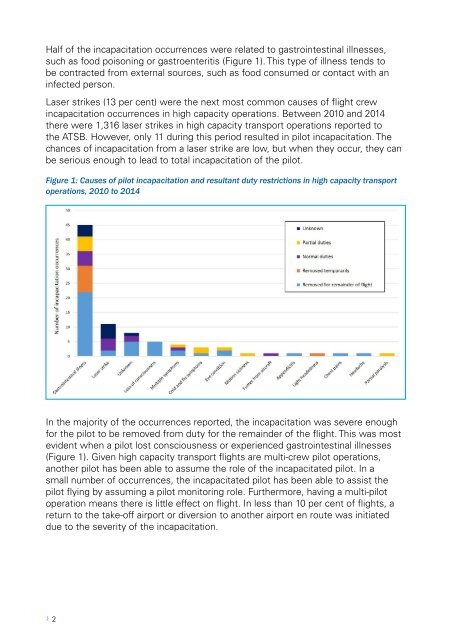Pilot incapacitation occurrences 2010–2014
8rKXy6YKY
8rKXy6YKY
You also want an ePaper? Increase the reach of your titles
YUMPU automatically turns print PDFs into web optimized ePapers that Google loves.
Half of the <strong>incapacitation</strong> <strong>occurrences</strong> were related to gastrointestinal illnesses,<br />
such as food poisoning or gastroenteritis (Figure 1). This type of illness tends to<br />
be contracted from external sources, such as food consumed or contact with an<br />
infected person.<br />
Laser strikes (13 per cent) were the next most common causes of flight crew<br />
<strong>incapacitation</strong> <strong>occurrences</strong> in high capacity operations. Between 2010 and 2014<br />
there were 1,316 laser strikes in high capacity transport operations reported to<br />
the ATSB. However, only 11 during this period resulted in pilot <strong>incapacitation</strong>. The<br />
chances of <strong>incapacitation</strong> from a laser strike are low, but when they occur, they can<br />
be serious enough to lead to total <strong>incapacitation</strong> of the pilot.<br />
Figure 1: Causes of pilot <strong>incapacitation</strong> and resultant duty restrictions in high capacity transport<br />
operations, 2010 to 2014<br />
In the majority of the <strong>occurrences</strong> reported, the <strong>incapacitation</strong> was severe enough<br />
for the pilot to be removed from duty for the remainder of the flight. This was most<br />
evident when a pilot lost consciousness or experienced gastrointestinal illnesses<br />
(Figure 1). Given high capacity transport flights are multi-crew pilot operations,<br />
another pilot has been able to assume the role of the incapacitated pilot. In a<br />
small number of <strong>occurrences</strong>, the incapacitated pilot has been able to assist the<br />
pilot flying by assuming a pilot monitoring role. Furthermore, having a multi-pilot<br />
operation means there is little effect on flight. In less than 10 per cent of flights, a<br />
return to the take-off airport or diversion to another airport en route was initiated<br />
due to the severity of the <strong>incapacitation</strong>.<br />
› 2


